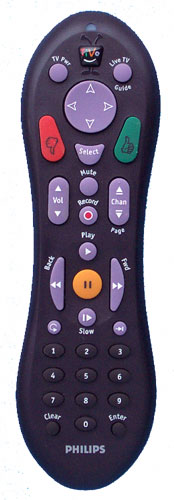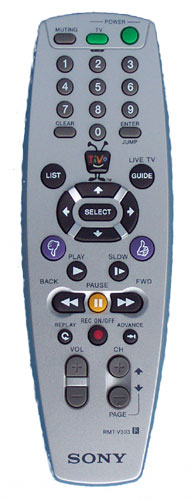TiVo DVRs are famous for their well-designed TiVo peanut remote. But not all TiVos use the peanut-shaped remote, and there are many versions of that remote that have been produced over the years.
The peanut remote (also referred to as the "dog bone" remote) sits very well in both right- and left-handed people's palms, and the button are laid out in a very usable and visually obvious format.
The first TiVos, manufactured by Philips, shipped with the original TiVo 32 button peanut remote.

(Original Philips Standalone TiVo Remote)
Like all other TiVo remotes, this model was "universal" in the sense that it could be programmed so speak to a television to control power and volume. The remote shipped with an internal, non-updatable database of codes for most television brands and models. Instructions are on-screen on every TiVo to help users program their remotes to work with the various compatible third party hardware.
The second TiVo model produced shipped with a remote with similar buttons, but with a very different layout. This unit was the Sony SVR-2000, and the remote was the RMT-V303. TiVo users with this remote grew very accustomed to this shape and format. Only three TiVo models were ever produced by Sony and they all used this remote, or a similar model, the RM-Y809. That model only worked with the DirecTV TiVo from Sony, the SAT T-60.

(Original Sony Standalone TiVo Remote)
Then, when Toshiba debuted their first TiVo DVR, the SD-H400, they created yet a different style of remote. This remote rearranged the buttons signifcantly, and didn't use the more hand-friendly form factor of the peanut and Sony varieties.

These three remote types are not cross-compatible at all, although most sophisticated universal remotes can emulate the top two.
TiVo Peanut Remote
The peanut remote is really the iconic remote identified by most people with TiVo. It's a remarkably easy to use remote, and many users are reluctant to go to a universal since they enjoy the feel and layout of the TiVo remote so thoroughly.
As a follow-up to the original 32 button varieties, the second generation of DirecTV TiVos and the Series2 standalone units started shipping with 34 button remotes. These remotes added the "TV Input" button to allow changes to the TV's selector, and Display or Info button to learn more about the currently playing show.

The second-generation peanut remotes also each had a selector switch on them - one type for DirecTV users, and another for standalone TiVo users.
On the DirecTV models, the switch allows selection between "SAT" and "TV." Having the switch in the SAT position means that the channel buttons control the TiVo. Having the switch in the TV position means the channel buttons control the TV, thus allowing for cable or antenna use on the TV, all through the same remote. This makes the TiVo remote reasonably universal in this situation.
For standalone users, the switch is marked "DVR 1-2" and allows for control of two DVRs from one remote. The TiVo and the remote need to each be programmed to work with only unique codes for this feature to work properly (see below).
Series3 TiVo Glo Remote
With the introduction of the TiVo Series3, TiVo made significant changes to the peanut remote. They added a backlighting feature with an ambient light sensor, a new, polished appearance, tactile feedback (clicks when you press the buttons) and the ability to "learn" IR codes for new equipment compatibility. While this remote was initially only available with Series3 TiVos, it later became available separately, and in a choice of white or black.
Programming Unique TiVo Remote Codes
Each TiVo DVR can listen to either all remotes, or only specific ones. And each remote can work with discreet TiVos, or all.
Essentially, each TiVo and each remote can, optionally, be set with a code from 1 to 9. The default code is 0, or, unset.
Once a TiVo is set to a number, for example 4, then that TiVo will only listen remotes that are either also set to 4, or to remotes that are unset. Conversely, remotes set to 4 will only communicate with TiVos set to 4, or TiVos that are unset.
So to use a remote with a DVR 1-2 switch to control two TiVos independently, you set the TiVo remote from position 1 with TiVo 1 and a unique code (probably 1). Then you switch the remote to 2, and set a unique code for it and the second TiVo. Full instructions for this type of programming are on TiVo's website.
In this way, up to nine TiVo DVRs can be controlled in the same room independently.
